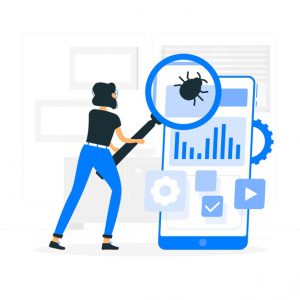If you ask a ransom product owner about QA roles and responsibilities in software testing, they will most likely say that a QA team is a bunch of testers. They sit quietly all day and look for software bugs. Some product owners might mention a Team Lead – a person who manages the QA engineers, and maybe even an Analyst without being certain about what this person does.
It’s time for a huge revelation: a QA team is usually even more diverse. It consists of profs who perform different tasks and have various responsibilities. There may be several QA engineers, Test Analysts, Test Architects, Test Managers, QA Team Leads, and other roles, depending on the complexity of the project.
Now, let’s try to figure out what contribution each of these roles makes.
Key QA Roles and Responsibilities
| Role | Responsibilities |
| QA Engineer | Guru of project documentation. The first one is to decide what to test and how. Knows exactly what the product should do. Systemizes the information to ease the QA engineer’s life. |
| Test Analyst | Look for ultimate solutions that will meet the client’s demands and align with the team’s resources. Has a complete vision of the software system. Knows every little feature and how it interacts with other features. |
| Test Architect | Takes full responsibility for the project’s success (or fail). Prepares test strategy, defines the scope of work for other members, and controls test execution. |
| Test Manager | Takes full responsibility for the project’s success (or fail). Prepares test strategy, defines the scope of work for other members, controls test execution. |
| QA Team Lead | The Supervisor. May take part in any process mentioned above, but usually just checks the status and manages the team. Conducts interviews. Hires and mentors new members. Deals mostly with managerial tasks rather than tech tasks. |
Now, let’s take a closer look at each role and its key areas of responsibility.

QA Engineer Roles and Responsibilities
A QA engineer carries out different tests. This member of a QA team checks a product for bugs and makes the list of defects for developers to fix. Some suppose that QA engineers fix bugs, but they never do. They only report what to improve. The improvement itself is a task for developers.
There are several ways to run tests. These ways define the roles and responsibilities of software test engineers. Perhaps you’ve heard about manual and automation testing. QA engineers with different qualifications are responsible for each type of testing.
The number of QA engineers working on a particular project depends on the particularities of this project. Automation is not always necessary, though it is more efficient in the long-term perspective. On the other hand, it is impossible to automate 100% of tasks. At least one manual QA engineer is always involved.
Manual QA Engineer Responsibilities
As you can guess from the title, this person conducts a software check manually. Some of the main responsibilities of a manual QA engineer include:
- analysis of requirements, preparing a query list based on those requirements;
- writing and executing test cases to detect usability and performance issues;
- conducting exploratory testing – simultaneous test design and execution;
- verification of multi-device and cross-platform consistency (software works on different devices and browsers);
- creating detailed reports and listing improvements;
- participation in test planning meetings and providing feedback to the testing team.
Skills
- Knowledge and understanding of the development process and software life cycle.
- Knowledge of testing methodologies.
- Proficiency in manual web/mobile/API/requirements testing.
- Familiarity with writing test documentation, requirements review, and creating bug reports.
- Understanding certain marking/scripting/programming languages, required for the project (e.g. JSON, HTML/CSS).
- Ability to describe bugs clearly and accurately.
Tools
- Test management tools: Xcode, Android Studio, Charles, Dev Console, Fiddler, etc.
- Project management tools: Jira, Confluence, Jenkins, Git, etc.
- Communication tools: Slack, Skype, Zoom, etc.
Role and Responsibilities of QA Automation Engineer
This team member uses special software to test a client’s system. A test automation engineer has more advanced skills than a manual tester. They need to run repeated tests using specific scripts and they often write those scripts. Test automation engineers are needed to perform testing that would require a lot of time if done manually. They usually do the following:
- write test scripts;
- carry out automated regression tests after every update and release of the new software version;
- run performance tests (load, stress, spike tests, etc.) to check how the software works in extreme conditions;
- set the priority for automation scenarios and work to maximize test coverage;
- write documentation on automated testing and select new automated tools.
Skills
- Knowledge and understanding of the development process and software life cycle.
- Knowledge of automation testing methodologies and programming language algorithms.
- Proficiency in web/mobile/API/requirements testing.
- Proficiency in writing automated tests, and test scripts.
- Ability to describe bugs clearly and accurately.
Tools
- Testing tools: Selenium, Katalon Studio, Test Complete, SoapUI, IBM Rational Functional Tester, Ranorex, etc.
- Project management tools: Jira, Confluence, Jenkins, Git, etc.
- Communication tools: Slack, Skype, Zoom, etc.
Test Analyst Role and Responsibilities
An analyst focuses more on business tasks and less on technical aspects. This person studies the formal requirements and curates QA engineers’ work. What kind of power does the QA analyst role provide? Test analysts can do the following:
- study and clarify testing requirements to QA engineers;
- determine what to test, prioritize the tasks, and monitor the test coverage;
- define specific tests, design test cases, schedule test execution;
- develop test documentation and deliver it to a product owner;
- compare actual and expected results, checking whether a product meets the requirements.
Skills
- Analytical thinking, is the ability to systematize information.
- Knowledge of project management systems, electronic document management, and software development life cycle.
- Proficiency in working with large amounts of data, collecting and documenting project requirements.
- Reviewing and writing technical documentation.
- Desire to study new technologies and products.
- Effective work management and communication.
Tools
- Analytic tools: Oracle SQL, Doker, Red Hat, Vmware, MS Office, iWork Suite, Google Docs, etc.
- Project management tools: Jira, Confluence, Jenkins, Git, etc.
- Communication tools: Slack, Skype, Zoom, etc.
Software Test Architect Responsibilities
A test architect helps to maintain a well-designed and sustainable test architecture in complex cases. If a QA engineer is responsible for the practical part, a test analyst focuses on implementing business requirements. Meanwhile, a test architect needs to make sure they work efficiently. Here’s what test architects usually do:
- work out the ways to optimize the testing process at a high level;
- identify tools and technologies that align with business goals, company infrastructure, and testers’ skills;
- monitor the effectiveness of testing, and provide mentoring and suggestions to improve testing practices.
Skills
- Knowledge of QA practices, testing methods and techniques, and scripting languages.
- Creating automation frameworks.
- Testing complex systems built with microservices architecture.
- Test data and test environment management, designing a test strategy.
- Strong management, organizational, and communication skills.
Tools
- Test automation toolkit (e.g.: Selenium, Test, Ranorex, Appium, Calabash).
- Software development support tools (e.g. Maven, Ant, Team City).
- Project management tools: Microsoft Suite, iWork Suite, Google Docs, Jira, Confluence, Jenkins, etc.
- Communication tools: Slack, Skype, Zoom, etc.
Software QA Manager Role and Responsibilities
This one has a key role in the team. A test manager is the first to find out how teamwork affects the outcome of a project. In the eyes of a product owner, this person is responsible for the outcome. A test manager controls analysts, architects, and QA engineers to make sure they deliver the result a client expects. For this, a test manager:
- prepares the test strategy for the project, defines the list of tasks for all;
- sets metrics to measure the quality of work and keeps track of everyone’s performance;
- calculates testing budget, estimates the efforts;
- supervises the testing part of the working process.
Skills
- Experience in team management (three or more people) and knowledge of different management techniques.
- Excellent knowledge of theoretical and practical principles of different testing types.
- Requirements analysis for writing test cases and creating test documentation.
- Effective prioritization of tasks, control of work terms & quality on all stages of development.
- Basic knowledge of web design, scripting/markup languages.
Tools
- Testing tools: Selenium, Katalon Studio, Test Complete, SoapUI, SoapUI, Postman, Ranorex, etc.
- Project management tools: Jira, Confluence, Jenkins, Git, TestRail, MS Office, Trello, iWork Suite, Google Docs, etc.
- Communication tools: Slack, Skype, Zoom, etc.
QA Lead Responsibilities
Welcome everyone’s boss! QA team lead handles the administrative part and communication with all the parties. QA lead role involves a wide range of responsibilities, mostly non-technical:
- hiring the staff – engineers, analysts, architects, and other members;
- supervision of team members and processes, ensuring team consistency;
- accepting the requirements from product owners and clarifying them to the team;
- setting quality metrics for the entire team;
- representing the team in cross-functional meetings;
- constantly improving the quality of testing and the working environment in general.
Skills
- Knowledge of web application protocols, scripting & markup languages, and databases.
- Experience in creating test documentation, prioritization of test cases, and test planning.
- Solid team management skills, and knowledge of effective team management practices.
- Excellent knowledge of theoretical and practical principles of different testing types.
- Strong communication skills for cross-functional communication with the development team and product owners.
- Ability to make decisions quickly in critical situations; responsibility, integrity, and sociability.
Tools
- Project management tools: Jira, Confluence, Jenkins, Git, TestRail, Trello, etc.
- Reporting & documentation tools: MS Office, iWork Suite, Google Docs, etc.
- Communication tools: Slack, Skype, Zoom, etc.
Other Roles
Some roles are not essential for every team. Usually, you can find those roles in big corporations with a strict hierarchy. Their responsibilities can be divided between other members or compensated with ready-to-use software solutions. For example:
- A system analyst consults on how to implement the approved requirements in a software product.
- A software development engineer in test works with software solutions for automation. They write and maintain test code but rarely perform testing.
- A test library and configuration specialist manages the test-script library with all its changes and creates new test builds.
- A network test engineer performs network and database testing, implements monitoring tools, and conducts load and stress tests. This role is more relevant for telecom and web service providers.
- A defect coordinator identifies testing risks, gaps, and trends. This team member assists in improving existing testing processes to ensure customer satisfaction in the future.
Who is a Full-stack QA Engineer? Do You Need Them, Too?

Usually, a QA engineer is responsible for a certain part of an application. They run either manual or automated tests. Different people can test documentation, usability, and performance, and run regression tests.
A full-stack QA engineer can handle all of those tasks single-handedly. Sometimes this person covers testing from the moment of defining project requirements up to a release day.
On the one hand, full-stack QA engineers cannot test big products, because it is very time-consuming. Also, full-stack testers are inferior to niche QA engineers when it comes to highly specialized knowledge.
On the other hand, a full-stack QA engineer helps to build a more agile testing process. They are familiar with all parts of software functionality. They know the product from both the development and user point of view. They think up-front about what to test and how to test at the beginning of the sprint.
A QA engineer finds bugs and provides developers with clear reports. Having a person who knows a product perfectly can help at any stage of testing and cover any tasks. It helps to optimize resources, increase team efficiency, and improve product quality.
A full-stack QA engineer in the team is not a must. Still, the team will benefit if they have one.
What Is QA Role In Agile Software Development Life Cycle?

In traditional SDLC models, testing comes after the development phase is over. However, QA engineers have limited time to check product features if they join a project this late. Agile QA roles and responsibilities work differently. Testing starts at the early stages and becomes continuous.
Development phases don’t have a strict order. They can overlap and repeat. An Agile team prefers short iterations with frequent releases instead of handing a final product over to a QA team. In this case, development and testing processes are simultaneous, flexible, and more efficient.
Requirements elicitation
The cases of requirement testing are rare. Still, they are important for project quality. During documentation development, QA engineers check the requirements for inconsistencies or logical gaps.
Planning & analysis
At this stage, a tester doesn’t have many tasks. Planning and analysis are more about keeping up to date. QA involvement helps to optimize the risks and create alignment. QA engineers get a better understanding of product functionality which allows finding bugs easier in the future.
Implementation
Developers and testers start to work closely together to create high-quality software. QA team actively participates in product development. They influence project quality directly by finding and reporting bugs.
Stabilization
QAs check all of the product features and estimate overall product quality. Testers have the power to approve software for release or send code to rework. The decision depends on the number of critical bugs.
Support
After the release, the QA team repeats the stages mentioned above over and over again during the product life cycle. They check new features, find new bugs during regular software inspection, and analyze bugs reported by users.
How Do You Organize an Effective Work of a QA Team?
The roles and responsibilities described above are not present in every team by default. Some roles merge, and specialists’ responsibilities change.
In-house teams don’t always have test automation engineers. A manual QA engineer can partially or completely perform the role of a QA analyst. The demand for a QA architect is more noticeable in big companies with complex infrastructures.
The best way to manage a team depends on the type of cooperation. You can hire n in-house QA team or work with a remote QA company.
If you work with an in-house team

- Explain your requirements and expectations clearly.
- Share your business goals so the team can understand what you plan to achieve.
- Keep in touch with the QA team to ensure continuous dialogue.
- Ask for feedback if you don’t get enough information.
- Ask questions if you don’t understand something.
If you work with remote QA specialists

- Follow all the points mentioned above.
- Discuss working schedules so different time zones won’t be an obstacle.
- Choose effective tools for communication and team management.
- Discuss the plan in case of an emergency or tight deadlines.
Bottom Line
There is no universal formula for an effective QA team. The size of the team depends on a specific project. The roles and responsibilities of team members do, too. When assembling a QA team, pay attention to the product complexity and business goals your company aims to achieve. Remember about the importance of quality assurance for agile software development.









